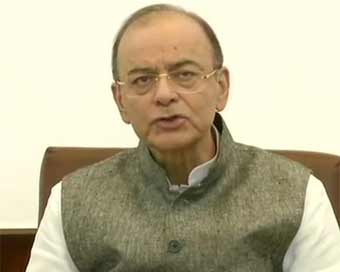 PM Modi visit USA
PM Modi visit USA Only the mirror in my washroom and phone gallery see the crazy me : Sara Khan
Only the mirror in my washroom and phone gallery see the crazy me : Sara Khan Karnataka rain fury: Photos of flooded streets, uprooted trees
Karnataka rain fury: Photos of flooded streets, uprooted trees Cannes 2022: Deepika Padukone stuns at the French Riviera in Sabyasachi outfit
Cannes 2022: Deepika Padukone stuns at the French Riviera in Sabyasachi outfit Ranbir Kapoor And Alia Bhatt's Wedding Pics - Sealed With A Kiss
Ranbir Kapoor And Alia Bhatt's Wedding Pics - Sealed With A Kiss Oscars 2022: Every Academy Award Winner
Oscars 2022: Every Academy Award Winner Shane Warne (1969-2022): Australian cricket legend's life in pictures
Shane Warne (1969-2022): Australian cricket legend's life in pictures Photos: What Russia's invasion of Ukraine looks like on the ground
Photos: What Russia's invasion of Ukraine looks like on the ground Lata Mangeshkar (1929-2022): A pictorial tribute to the 'Nightingale of India'
Lata Mangeshkar (1929-2022): A pictorial tribute to the 'Nightingale of India' PM Modi unveils 216-feet tall Statue of Equality in Hyderabad (PHOTOS)
PM Modi unveils 216-feet tall Statue of Equality in Hyderabad (PHOTOS)The Badminton Association of India (BAI) has announced a 14-member-strong India squad for
- Men’s Sr Hockey Nationals to be played in division-based format from April 4
- Mensik denies Djokovic 100th title in Miami final
- KIPG: Son of a vegetable vendor, Bihar’s Jhandu Kumar eyes Worlds, 2028 Paralympics
- Hardik Singh credits hard work and team unity for receiving HI Midfielder of the Year award
- Djokovic, Alcaraz land in same half of Miami draw
Confiscation of cash was not the aim: Jaitley on note ban Last Updated : 08 Nov 2018 04:14:43 PM IST 
Finance Minister Arun Jaitley As the country completed two years of demonetisation, Finance Minister Arun Jaitley on Thursday said the objective was not to get the cash deposited in banks but to move towards a more formal economy that he claimed is giving rich dividends.
"An ill-informed criticism of the demonetisation is that almost the entire cash money got deposited in the banks. Confiscation of currency was not an objective of demonetisation. Getting it into the formal economy and making the holders pay tax was the broader objective," Jaitley said in a Facebook blog.
"The system required to be shaken in order to make India move from cash to digital transactions. This would obviously have an impact on higher tax revenue and a higher tax base," he added.
Demonetisation was a key step in a chain of important decisions taken by the government to formalise the economy, he said.
Other major decisions include targeting the black money outside India, application of technology in filing of returns and expanding the tax base, financial inclusion to integrate weaker sections with the formal economy, Jan Dhan accounts, Aadhaar law, Direct Benefit Transfer and the Goods and Services Tax (GST).
"It is now becoming increasingly difficult to evade the tax system," he said.
The Minister said direct tax collections in the two years prior to demonetisation had risen by 6.6 per cent and 9 per cent, which in the two years post-demonetisation rose by 14.6 per cent and 18 per cent with increases registered both in personal income tax and corporate tax.
Similarly, in the year 2017-18, the tax returns filed reached 6.86 crore, an increase of 25 per cent over the previous year. This year, as on October 31, already 5.99 crore returns have been filed which was an increase of 54.33 per cent compared to the previous year.
"In May 2014, when the present government was elected, the total number of the filers of income tax returns was 3.8 crore... By the time the first five years of this government are over, we will be close to doubling the assessee base," he said.
Demonetisation and implementation of the GST curbed cash transactions and boosted digital transactions, the Minister said.
"This formalisation of the economy has led to the tax payer base increase from 6.4 million in the pre-GST regime to 12 million tax payers in the post-GST regime."
The actual consumption of goods and services being recorded in tax net had now increased, giving a buoyancy to the indirect tax growth, benefiting both the Centre and the states.
In 2014-15, the indirect tax to GDP ratio was 4.4 per cent. Post-GST it has climbed to 5.4 per cent.
"Rates of taxes, both direct and indirect, have been reduced, but tax collections have gone up. The tax base has been expanded. GST rates on 334 commodities which were paying an effective 31 per cent tax pre-GST have witnessed a tax reduction," he said.
Further, Jaitley said measures taken for digitisation including the Unified Payment Interface (UPI) and the Bharat Interface for Money (BHIM) have resulted in increased transactions.
"Today Visa and Mastercard are losing market share in India to indigenously developed payment system of UPI and RUPAY Card whose share have reached 65 per cent of the payments done through debit and credit cards," he said.
The Minister said more formalisation of the economy will lead to more revenue and more resources for the poor, better infrastructure and a better quality of life for the citizens.IANS New Delhi For Latest Updates Please-
Join us on
Follow us on








172.31.16.186







